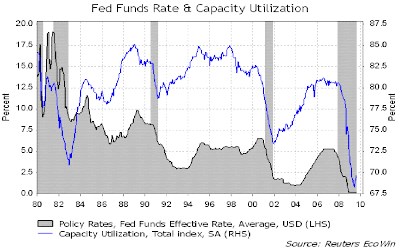In response to this morning's data the Jan 2011 Fed funds contract is down near 10bp in price -- an implied yield of 1.5%, an expectation of a more than 130bp increase in the funds rate between now and then. While this is more realistic than last August when the Jan 2011 contract was priced to a 2.25% Fed funds rate, 1.5% is still out of line with historic experience. The Fed waits for utilization rates to recover quite a bit before acting, as illustrated below and as I wrote a few weeks back ("Before the Minutes -- Capacity Utilization Says At Least 35 Months Before First Rate Hike". Those 35 months are still there at a minimum considering that utilization rates today are still far below the lows of the past three recessions. You can still bet against Fed tightenings.

Further supporting the case that it is going to be a while before the Fed begins to take away stimulus is to compare factory utilization rates for hi-tech with the auto industry. Automobile manufacturing may be the industry of what was but it is still big enough to impact the overall stats for manufacturing activity. So before dismissing the poor state of factory activity in the U.S. as an automobile-induced event, it is worth seeing how some other industries are faring. Oil and gas extraction, for example, remain at full capacity. Hi-tech is a key industry to watch because it offers, with its virtual highway, the road map for U.S. industrial growth. The chart below illustrates that since the 2000-02 dot com bust the sector appears to be much more pro-cyclical. In fact, utilization rates in this decade never topped the late 90s levels let alone the Y2K-induced peak in 2000-01. There is a reason why Bernanke noted the fragility of the upturn. He is going to wait a long time before making industry pay more for the credit off of which the economy expands.

No comments:
Post a Comment